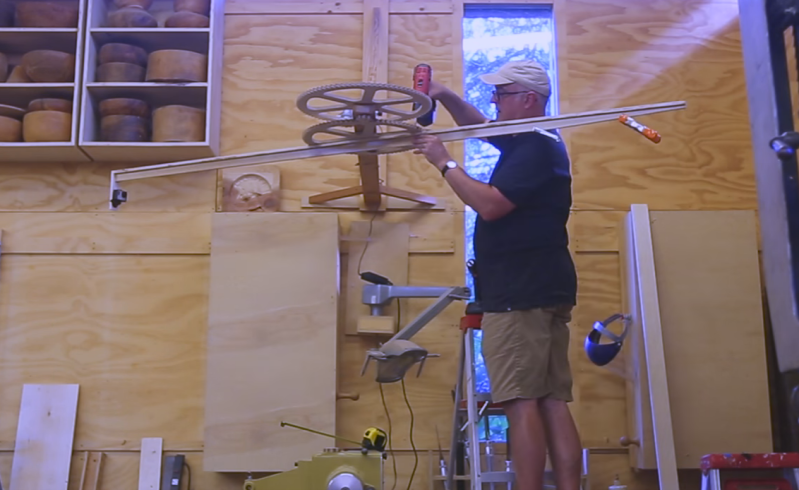The combination of time-lapse photography and slow camera panning can be quite hypnotic – think of those cool sunset to nightfall shots where the camera slowly pans across a cityscape with car lights zooming by. [Frank Howarth] wanted to replicate such shots in his shop, and came up with this orbiting overhead time-lapse rig for his GoPro.
[Frank] clearly cares about the photography in his videos. Everything is well lit, he uses wide-open apertures for shallow depth of field shots, and the editing and post-production effects are top notch. So a good quality build was in order for this rig, which as the video below shows, will be used for overhead shots during long sessions at the lathe and other machines. The gears for this build were designed with [Matthias Wandel]’s gear template app and cut from birch plywood with a CNC router. Two large gears and two small pinions gear down the motor enough for a slow, smooth orbit. The GoPro is mounted on a long boom and pointed in and down; the resulting shots are smooth and professional looking, with the money shot being that last look at [Frank]’s dream shop.
If you haven’t seen [Frank]’s YouTube channel, you might want to check it out. While his material of choice is dead tree carcasses, his approach to projects and the machines and techniques he employs are great stuff. We featured his bamboo Death Star recently, and if you check out his CNC router build, you’ll see [Frank] is far from a one-trick pony.
















Frank puts so much work in his videos – so awesome!
very nice and simple build. One suggestion would be to aim the camera so the centre of rotation is closer to you/your lathe. Its a little jarring pivoting around a point in space instead of where your eye is supposed to be drawn. And fyi, what you have there is technically a frame or truss and not a cantilevered beam.
The whole thing’s got a sort of dolly zoom feel to it even though there’s no zoom, especially the last half of the maneuver when the room opens up. Unnerving.at any rate.
It is cantilevered. Beams, trusses and plates can all be cantilevered. Cantilevering refers to the fact it is only supported on one end.
I wonder if two step reduction is an overkill. What angular resolution do you need in order for video to be smooth? Most stepper motors do about 200 steps per full circle, with a microstepping controller you can get this 16 fold, plus 1:10 one stop reduction this takes us roughly to 0.01 degree per step. Given a 2 meter arm, i get 0.35mm travel per step, surely that’s smooth enough, unless I messed up my maths.
Well, except that he’s using a ≈10rpm gearmotor instead of a stepper.
Yeah. I too would chose the electornic approach: Have an arduino step a small stepper, one of those cheap geared 2000 steps per revolution ones. And then a 1:10 reduction would easily be enough.
But everybody uses the tools he’s most familiar with. This guy is good with wood, so he used the wooden gears….
That workshop is fantastic.
Sadly it seems to not be able to do a 360 I wonder what he uses to make it stop trying to turn when it hits the wall like it did at the end.
Probably forgetting to cut another notch for the beam to go under the drive gear, since he only mentioned it once. (at 7m through 7m13s )
Yeah, and I get the impression that the location for the cutout is quite sloppy and off by quite a bit…